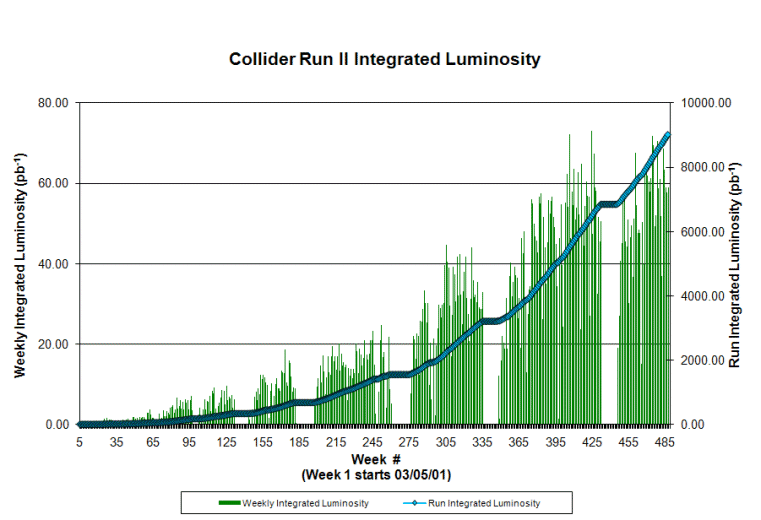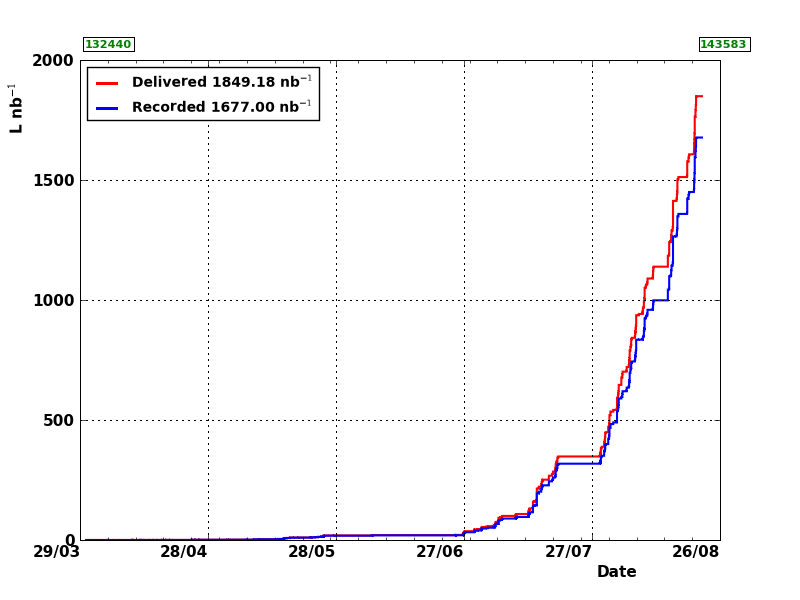The quantity that one wants to have a look at when we discuss data collection at a particle collider is integrated luminosity. Luminosity is a measure of the number of collisions that take place in the collision point (typically located at the geometrical center of a detector) per second of collider operation. As such, it is of course clear that one wants to discuss the "integrated" luminosity -the product of luminosity by time of operation. However, if we want to be precise, luminosity is not a measure of the number of collisions; rather, it is a number that tells about the intensity of illumination of the collision region with the particle beams.
The distinction is formal -it boils down to having to express luminosity in units that are the inverse of an area per second- but it does have consequences. In principle, if you need to compute the number of collisions that have yielded a top quark pair you do not need at all to know the sheer number of proton-proton collisions that took place in the core of the CMS experiment : you in fact only need to know the number of collisions "per unit area" L -that is, how intensely illuminated was the collision point-, and the cross-section of top pair production S at the energy of LHC operation. You multiply the two (a number per unit area L by an effective area S), and get the number you want: N= LxS.
 The specification is important when you compare the yield of two different colliders, that operate at different energy (2 TeV at the Tevatron, and 7 TeV at the LHC) and collide different particles (proton versus antiproton at the Tevatron, and proton versus proton at the LHC). This is because the cross section S for any given process is a steep function of the collider energy, as is well described in the graph on the right.
The specification is important when you compare the yield of two different colliders, that operate at different energy (2 TeV at the Tevatron, and 7 TeV at the LHC) and collide different particles (proton versus antiproton at the Tevatron, and proton versus proton at the LHC). This is because the cross section S for any given process is a steep function of the collider energy, as is well described in the graph on the right.In other words, if you are interested to know how many events of a given kinds were produced by the Tevatron with 8 inverse femtobarns of luminosity, and by the LHC with 2 inverse picobarns, you need the different values that S takes for the given process at the two energies and with the two different sets of colliding bodies.
In the graph, you observe clearly that there are processes at the top for which the cross section (on the vertical axis) does not grow dramatically with colliding energy (sqrt(s), on the horizontal axis): these are the processes that involve a small energy release when compared to the total "nominal" available energy of the beams. We go from total independence (the total inelastic cross-section for proton-proton interactions, which by the Pomeranchuk theorem is rather constant with energy) to mild increases (for instance, the production of b-quark pairs, the second-highest curve shown), to very steep dependence on energy for the rarest processes which imply a very high energy release. For a 500-GeV Higgs boson (the curve at the bottom of the graph), the cross section rises by a thousand times when we go from 2 to 7 TeV of center-of-mass energy.
The reason why very energetic processes benefit the most of an increase of the colliding beam energy is that these processes are triggered by the collision of quarks that are found to possess a very large fraction of the total proton energy. This is a very rare occurrence, so these collisions are rare.
Now let me show you where the two accelerators are as far as integrated luminosity is concerned, as of today. The Tevatron has been collecting heaps of data in the last few years, as is described by the graph below: over 8 inverse femtobarns of collisions. While deceiving, I like to explain it as follows: it is as if the beams "painted" with eight collisions each square with sides of 10^-18 meters.

The LHC has instead just started -and it is still ramping up its power. The integrated luminosity is 4000 times smaller, as shown by the graph below; but we expect it to grow quickly in the next few months.

It is interesting to know that already with one four-thousandth of the luminosity should be sufficient for the LHC experiments to surpass the sensitivity of the Tevatron experiments on selected few very high-energy processes. I imagine that the competition between the two sides of the Atlantic will grow exponentially in the forthcoming months -so the winter conferences should be way more interesting and blood-ridden than the relatively peaceful ICHEP!
Oh, and -lest I forget- let me make clear something here: while I am a member of the CDF experiment and the CMS experiment, what you read above are just my own ruminations and you should not be fooled into taking them as an official source of information about the operation of the accelerators or the experiments I cited!




Comments